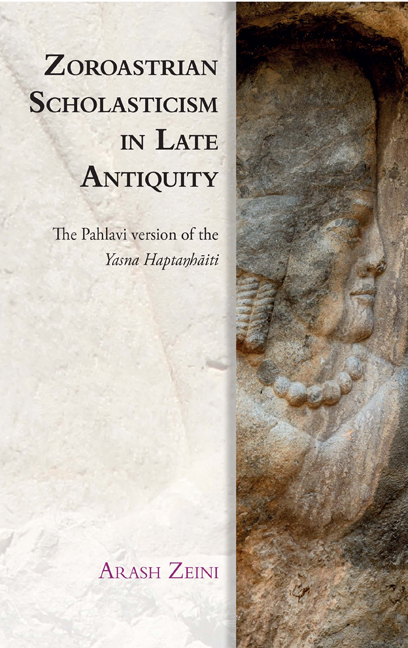Book contents
- Frontmatter
- Contents
- List of Figures
- List of Tables
- Acknowledgements
- Series Editor’s Preface
- Preface
- Conventions
- Abbreviations
- Dedication
- Part I Introduction
- 1 Introduction
- 2 The Zand
- 3 Scholasticism
- 4 Fire in Zoroastrianism
- 5 Precis: Yasn Ī Haft Hād
- Part II Text and translation
- 6 PY 35
- 7 PY 36
- 8 PY 37
- 9 PY 38
- 10 PY 39
- 11 PY 40
- 12 PY 41
- Part III Miscellaneous Observations
- 13 PY
- 14 PY 36
- 15 PY 37
- 16 PY 38
- 17 PY 39
- 18 PY 40
- 19 PY 41
- Part IV Epilogue
- 20 Reflections on the Zand
- Appendices
- Appendix A Transliteration and Apparatus
- Appendix B Y 9.1
- Appendix C Fire in the Older Avesta
- Appendix D Iϑā
- Appendix E MSS Concordance
- Bibliography
- Index of Passages Quoted
4 - Fire in Zoroastrianism
Published online by Cambridge University Press: 14 October 2020
- Frontmatter
- Contents
- List of Figures
- List of Tables
- Acknowledgements
- Series Editor’s Preface
- Preface
- Conventions
- Abbreviations
- Dedication
- Part I Introduction
- 1 Introduction
- 2 The Zand
- 3 Scholasticism
- 4 Fire in Zoroastrianism
- 5 Precis: Yasn Ī Haft Hād
- Part II Text and translation
- 6 PY 35
- 7 PY 36
- 8 PY 37
- 9 PY 38
- 10 PY 39
- 11 PY 40
- 12 PY 41
- Part III Miscellaneous Observations
- 13 PY
- 14 PY 36
- 15 PY 37
- 16 PY 38
- 17 PY 39
- 18 PY 40
- 19 PY 41
- Part IV Epilogue
- 20 Reflections on the Zand
- Appendices
- Appendix A Transliteration and Apparatus
- Appendix B Y 9.1
- Appendix C Fire in the Older Avesta
- Appendix D Iϑā
- Appendix E MSS Concordance
- Bibliography
- Index of Passages Quoted
Summary
Any text is the absorption and transformation of another.
Kristeva (1980)Most observers, modern or ancient, would state that fire plays a pivotal role in Zoroastrianism. It appears to dominate the ritual performed by the priests in fire temples (ātaškade in Persian) or in private by the Zoroastrian laity, a practice for which Zoroastrians have come to be known as fire worshippers. Priestly and academic scholarship traces the roots of the fire's centrality back to prehistoric times, viewing it as a continuation of common Indo-European and Indo-Iranian traditions. Boyce (1987), for instance, suggests that the cult of the fire predates Zoroastrianism and likely originates in IE traditions. In her view, it is the ever-burning hearth fire which is often regarded as the predecessor of the Zoroastrian fire. Mobad Azargushasb (1971) considers fire to be a universally revered element, respected in various cultures across ethnic boundaries. Dastur Kaikhusroo Jamaspasa (2003) describes the fire in terms reminiscent of (P)Y 36.6: ‘Fire also brought a bit of the heavens down to earth as it resembled the sun in the sky.’
Within the extant corpus of Avestan texts, Y 36 contains one of the earliest references to the fire in the context of an Avestan ritual. With Y 36 marking the middle of the 72 hāiti of the Yasna, the fire occupies a central position in the ritual and emerges as one of the principal concepts of Zoroastrianism. The hāiti also marks the start of a departure from a single fire towards multiples with highly complex connections encountered in later texts. The tendency to build layered and complex networks of ideas has long been recognised in manuscript traditions (see Section 4.4). In the following, I shall trace the development of the fire in Zoroastrian textual traditions from the Older Avesta through to the MP texts, examining to what extent a scholastic view of the scripture could have influenced the unfolding of the fire's position within later forms of Zoroastrianism.
However, before I proceed with the actual study, some preliminary remarks on the term ‘fire’ are in order. The word for fire is ātar- in OAv., YAv. as well as OP; ātaxš and ādur in Middle Persian and Parthian, and ʾʾtr in Sogdian. It is cited four times in the Bactrian documents as a loanword from MP ādur.
- Type
- Chapter
- Information
- Zoroastrian Scholasticism in Late AntiquityThe Pahlavi Version of the Yasna Haptaŋhāiti, pp. 63 - 97Publisher: Edinburgh University PressPrint publication year: 2020



